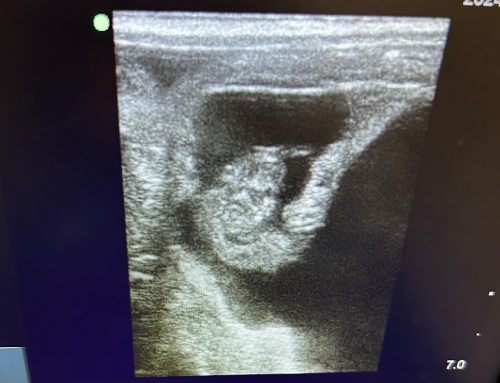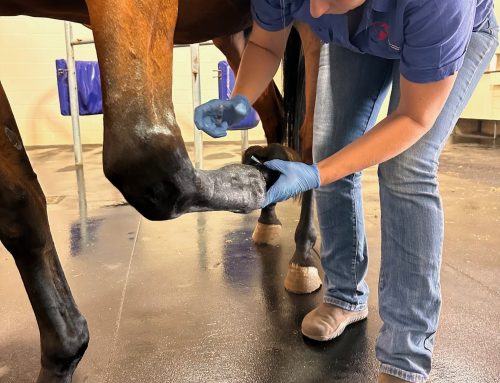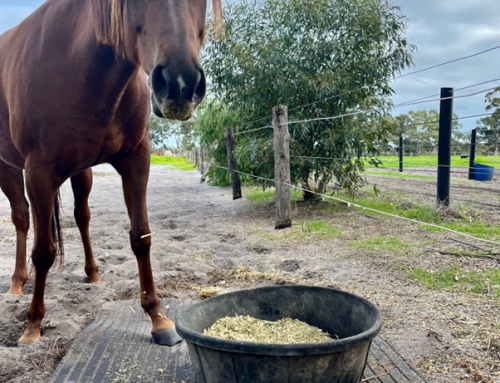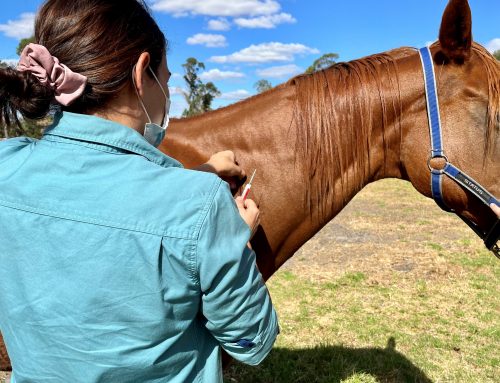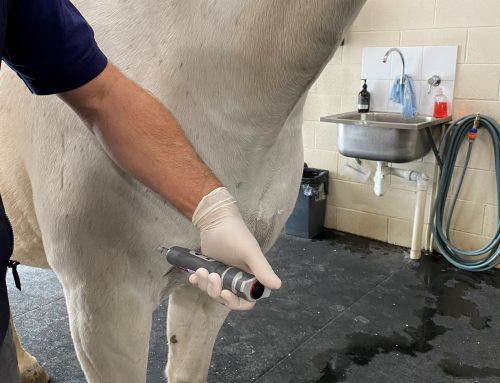By Dr Ross Wallace Bsc BVMS (hons) MANZCVS (eq surg)
Foaling down your own mare can be daunting prospect for even the most seasoned horse person. Despite this, the process of getting your mare pregnant, following the pregnancy scans and then finally seeing the end result is all absolutely worth it.
The question is …. Are you ready for it?
Preparation of the mare
Broodmares should be on a good plane of nutrition leading into foaling and have a sufficient body condition to help support pregnancy, foetal growth and the process of lactation. All mares should receive a tetanus and strangles vaccine 4-6 weeks prior to foaling. The neonate relies of sufficient transfer of antibodies in the colostrum to prevent disease before its own immune system is established.
Mare should be administered a wormer 2-4 weeks prior to the anticipated due date. An ivermectin based wormer is best used in this scenario.
Maiden mares require special attention to become accustomed to the nursing foal . Often these mares are not use to having their teats touched and are often very reactive. By regularly handling the udder leading up to foaling can desensitise the mare to this stimulation and assist with the nursing process.
Is the mare caslicked?
Many broodmares have had a caslick procedure (suturing of the upper vulval lips) performed once they are confirmed pregnant to help prevent placental complications. Failure to remove a caslick may result in unnecessary vulval tearing or a potentially difficult birth. If you are unsure your veterinarian can check for you.
The foaling paddock
It is generally advised given the beautiful climate we have in Australia that mares foal in a suitable paddock as opposed to a stable environment. Careful consideration should be given to the paddock chosen to foal your mare in. The paddock should be close to your house and easily accessible in the night hours. The area should have been rested and manure removed to provide a clean environment for the newborn foal. A flat grass covered area is preferred with no obstacles or potential water hazards present.
Priority should be placed on the type of fencing used in the foaling paddock. The use of mesh or chicken wire prevents foals easily rolling under a fence in the middle of the night which foals seems very clever at achieving.
Access to good lighting over the paddock is always a good investment. This allows careful observation of the mares behaviour leading up to foaling and close observation of the newborn from a distance.
Have you organised assistance?
It has been said that having a plan is better than no plan at all. Whilst we all want the foaling process to be a smooth event, occasionally assistance is required. It is advised to contact your local equine veterinarian in the week leading up to foaling and discussing what arrangements are available outside normal hours. This is a good time to confirm the out of hours number and predicted time of assistance if required.
Otherwise the prearranged help of a ‘horsey’ neighbour is always helpful in a stressful situation.
Prediction of foaling
The average gestation length for a mare is 340 days. There may be a lot of variability although individuals tend to follow similar patterns year after year. As the mare gets closer to foaling there are some physical changes that will occur. Firstly, the muscles around the tail head will relax in the weeks leading up to parturition. The vulva will lose the tight wrinkled appearance and begin to elongated and appear relaxed in the days prior to foaling. This is more evident in mares that have had several foals.
The most notable change is the in the mammary glands. The udder will begin to fill 2-4 weeks prior to foaling with milk let down into the teats 4-6 days prior to foaling. In the 48 hours prior small secretions of colostrum may dry up on the end of each teat in a process known as ‘waxing up’. Up to 90% of mares will foal within 48 hours of waxing up. Some mares may run milk from the teats for 24 hours prior to foaling. Should the running of milk continue beyond 24 hours then your veterinarian should be advised.
Serial assessment of the pH of mammary secretions is an inexpensive and reliable method to help with foaling prediction. Most mares with normal pregnancies foal with a pH of secretion of 6.2-6.6. This can be measure with the use of pool test strips from your local hardware. Theses secretions can be checked daily close to foaling and the mares monitored more closely when the pH drops suddenly into this range. Although this is a helpful method it should be interpreted with other physical changes to the mare as not all mares drop their pH in the same way
It is important to note that every mare is different in their changes prior to foaling and should be assessed accordingly
Foaling Alarms
A number of systems are available to alert the owner or foal attendant that the foaling process has commenced. The most common systems in Australia rely on a signal from the mare’s head collar to alert the owner the mare is laying down. Newer systems available will also track head movement to differentiate the sleeping mare from the rolling mare. This usually requires a wifi connection to the paddock.
Foaling alarms are almost considered a must when foaling down your mare as the process is quick and explosive and easily missed. Whilst these devices are helpful they will never replace direct visual observation. Regular checking of the battery status and range of these monitor is critical to prevent failure.
The Foaling Kit
Having all your supplies in a bucket by the paddock is a must. The kit should contain
- Head torch
- Tail bandage
- Towels
- 2% chlorhexidine solution or Betadine in a small jar for dipping umbilicus
- Foal enema (fleet enema)
- Digital thermometer
- Rubber exam gloves
- Head collar / rope
- Stopwatch
- Bag for placenta
Stages of Labour – What Happens Now?
There are three recognized stages of labour
- Stage 1 – positioning of the foal
- Stage 2 – expulsion of the foal
- Stage 3 – passing of the membranes
Stage 1 – During this stage the foal rotates from being on its back to extending its head and feet into the birth canal. During this time mares can appear restless,may pace up fence lines, flank watch and may sweat in the flanks. This process can last several hours. Mares should be monitored from a distance during stage 1. The end of the first stage of labour is marked by the rupturing of the membranes and release of foetal fluid. This usually happens 1-4 hours after stage 1 has commenced.
Stage 2 – Active contractions will follow the passing of fluid once the waters have broken. The mare may continue to stand or lay down during this time. A white membrane (amniotic sac) should potrude from the vulva. The foal should be positioned with one foot in front of the other with the toes pointing down. The feet are followed by the nose and head resting between the knee. Once the head is free the mare will commence some forceful contractions to help the shoulders through the pelvic canal. The rest of the foal will then be delivered.
The foal should be delivered within 15-20 minutes from the start of stage 2. If the foal is not progressing or the presentation is abnormal please contact your veterinarian immediately.
Once delivered carefully removed the amniotic sac from the foal’s nose and allow the foal time to bond with the mare. Do not attempt to clean the foal excessively as the mare licking the foal is part of the maternal bonding process.
Leave the mare to lay for as long as possible to prevent premature rupture of the placenta. The umbilicus should break on its own once the mare stands. The foal umbilical stump can be treated at this stage with the umbilical dip in your foal kit.
The birth of the foal marks the ends of stage 2 labour
Stage 3 – The mare will normally pass the membranes within 30 minutes of foaling although some mares will take 3-4 hours to expel the membranes. The mare may show some discomfort as the uterus contracts to assist with removal of the membranes.
Under no conditions should the membranes be pulled from the mare. Should the membranes not be passed in 4-6 hours then the veterinarian should be called to assist with removal. Retained membranes in the broodmare can have serious consequences including uterine infection and laminitis.
The membranes should be kept in a bag or bucket and examined by your veterinarian at the foal exam to ensure all membranes are present. Remember to ‘check it and not chuck it’.
What Is Normal For the Newborn Foal?
Foals should sit up within minutes of arrival and respond to surrounding stimuli. A suck reflexes is usually present within 10-20 minutes of birth and efforts to stand should commence within this time frame. The 1, 2,3 rule should apply for a new foal. Standing in the first hour, drinking by the second hour and membranes passed by the third. Should a foal take longer than 3-4 hours to nurse then this should be considered abnormal.
Most foals will have their first urination after 9 hours and pass meconium (first black tar like poo) within 4 hours. Foals straining to pass meconium should receive an enema. Healthy foals should seem vibrant and interested in their environment and nurse approximately 4 times and hour. Should your new born foal not reach these targets then a discussion with your veterinarian is warranted.
Immunity test
Foals receive antibodies from the mare’s colostrum in the first 12 hours of their life. The ingestion of good quality colostrum is crucial in this period to boost their immune system against any potential challenges. This immunity can be tested by a simple blood test from 16 hours after foaling. This test is not expensive or invasive and can detect deficiencies in the foal’s immunity that can be corrected.
The Post Foaling Check
Having your mare and new born foal examined by an equine veterinarian 24 hours after foaling is strongly encouraged. This examination can detect any problems with the mare, allow evaluation of the placenta and provide a comprehensive evaluation of the foal. Problems including limb deviations, septicaemia, and rib fractures can be evaluated. A thorough check of the mare should be performed to detect any post foaling tears or problems that may impact her future breeding potential.
The foaling process is enjoyable for the well-prepared horse owner. Sleepless nights are always offset by the pleasure of watching your new foal canter around the next morning. Good luck with your journey!


